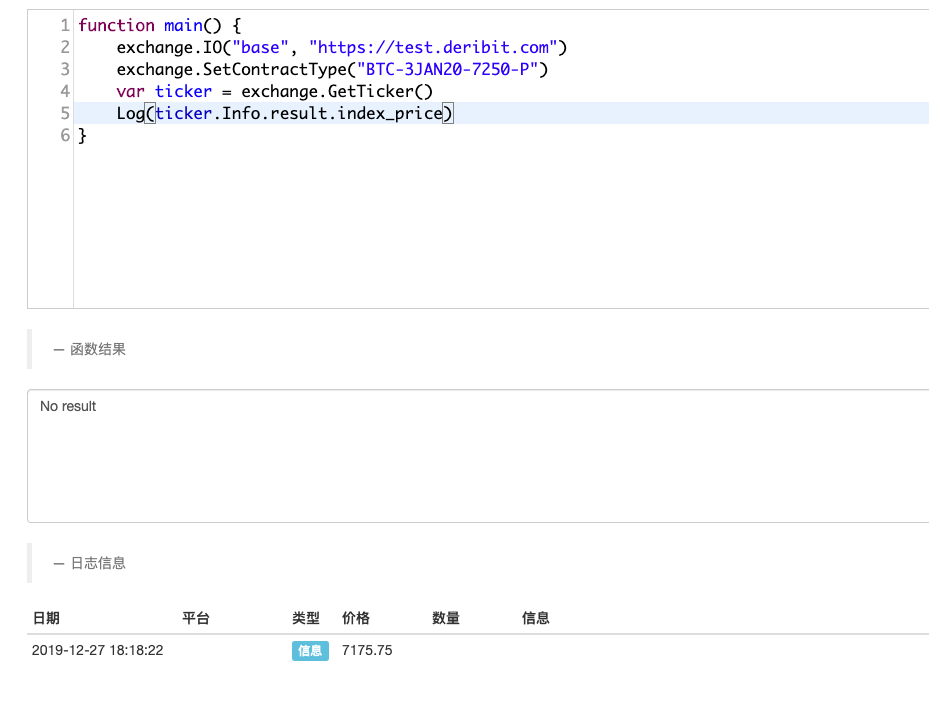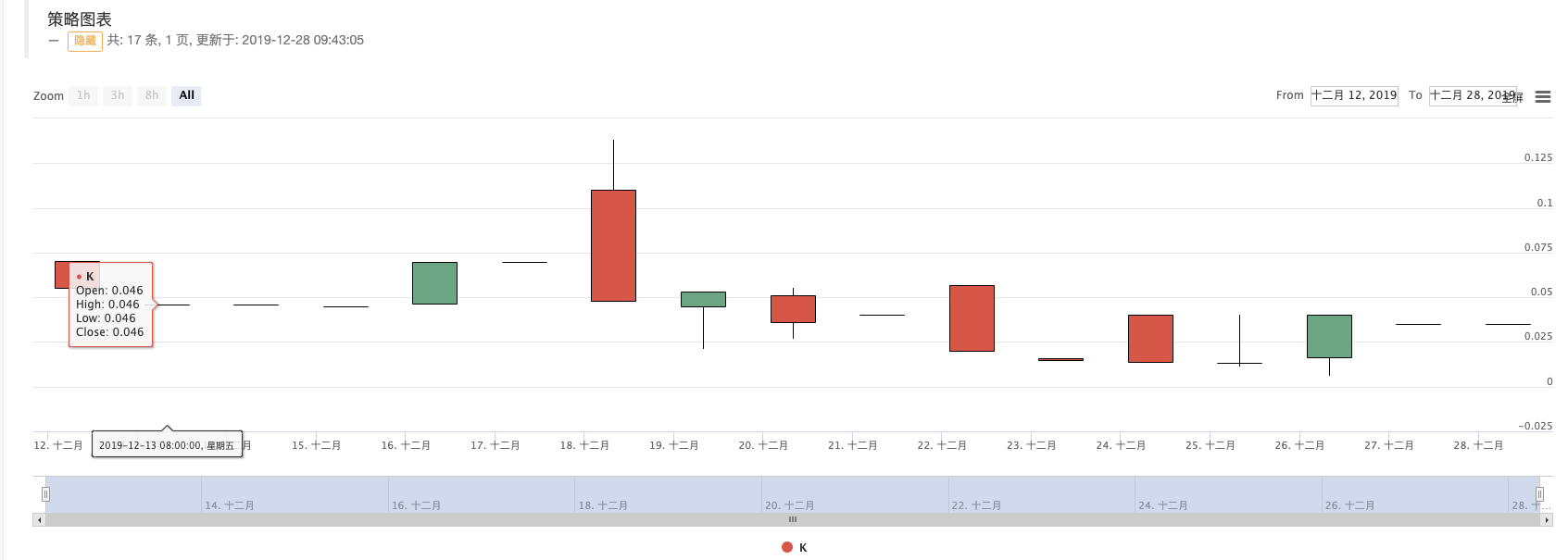Quantified trading tools for open-source digital currency options
Author: The Little Dream, Created: 2019-12-27 17:35:30, Updated: 2023-10-17 21:26:52
Quantified trading tools for open-source digital currency options
1, Quantitization of digital currency options, processed trading
Recently, many exchanges have opened the trading function of this derivative of digital currency options, and similar to traditional options, options trading and futures trading, etc. can be combined to combine many trading strategies, trading methods. Although there are many open source quantitative trading tools on the market, these tools require knowledge of the underlying framework, familiarity with the programming language of the framework or need to manually perform complex debugging, configuration, modification.
The inventor quantifiedFMZ.COMIn the early architecture design, the support for various financial derivatives quantification and programmatic trading was considered, and very fast access to options trading was provided. Options trading is basically similar to futures trading, even simpler. And without adding new interfaces, users familiar with FMZ do not add other learning costs.
2, directly access the Deribit exchange using the native programming language
Let's take the example of an option contract on the Deribit exchange, for example, we want to get the index price of a current option contract.
The Go language is used to:
package main
import "net/http"
import "io/ioutil"
import "fmt"
import "encoding/json"
func main() {
// 获取行情, 访问接口:https://www.deribit.com/api/v2/public/ticker?instrument_name=BTC-27DEC19-7250-P
resp, err := http.Get("https://www.deribit.com/api/v2/public/ticker?instrument_name=BTC-27DEC19-7250-P")
if err != nil {
panic(err)
}
defer resp.Body.Close()
body, err := ioutil.ReadAll(resp.Body)
if err != nil {
panic(err)
}
ret := string(body)
fmt.Println("这只是字符串数据ticker:", ret)
fmt.Println("需要转换为JSON格式")
type js struct {
data interface{}
}
ticker := new(js)
json.Unmarshal([]byte(ret), &ticker.data)
fmt.Println("ticker:", ticker)
fmt.Println("ticker 中的标记价格数据index_price:", ticker.data.(map[string]interface{})["result"].(map[string]interface{})["index_price"])
}

You can see that just to get this data, you write N more stacks of code.
3 The interface used by the inventor to quantify the platform packaging
We've solved it with two simple sentences from FMZ.
function main() {
exchange.IO("base", "https://test.deribit.com") # 切换为 交易所提供的模拟盘
exchange.SetContractType("BTC-3JAN20-7250-P") # 设置期权合约
var ticker = exchange.GetTicker() # 获取期权行情
Log(ticker.Info.result.index_price) # 打印需要的数据,观察
}

As you can see, with just a few lines of code, it's easy to get the data you need.
This is simply a public API interface for non-signature access to an exchange, which is more complicated if you access a private interface for signature.
Each interface also handles a bunch of signatures, parameters, etc.:
strBody := ""
strQuery := ""
ts := toString(time.Now().UnixNano() / 1e6)
nonce := toString(time.Now().UnixNano() / 1e6)
uri := resource
if httpMethod == "GET" {
strQuery = encodeParams(params, false)
uri = fmt.Sprintf("%s?%s", resource, strQuery)
} else if httpMethod == "POST" {
if len(raw) > 0 && len(raw[0]) > 0 {
strBody = raw[0]
} else {
strBody = json_encode(params)
}
}
strRequestDate := fmt.Sprintf("%s\n%s\n%s\n", httpMethod, uri, strBody)
strToSign := fmt.Sprintf("%s\n%s\n%s", ts, nonce, strRequestDate)
h := hmac.New(sha256.New, []byte(p.secretKey))
h.Write([]byte(strToSign))
strSign := hex.EncodeToString(h.Sum(nil))
req := Request{
Method: httpMethod,
Uri: fmt.Sprintf("%s%s", p.apiBase, uri),
Timeout: p.timeout,
Body: strBody,
}
4, more complex needs, functions
Not only that, if you need to use a database that requires concurrency, asynchronous acquisition, ordering, and processing of asynchronous code, you need to write a more complex asynchronous processing logic, and a non-resident can also cause logical design problems such as deadlock. If you need to use a graph to show, then you need to learn how to use a large database, even a programming-based quantitative trader, it will take some time to learn.
function main(){
exchange.IO("base", "https://test.deribit.com")
exchange.SetContractType("BTC-27DEC19-7250-P")
while(1){
var records = exchange.GetRecords()
Log(records)
$.PlotRecords(records, "K")
Sleep(1000)
}
}
Using the template library "Draw Line Library" provided by the platform, it is very simple to draw a K-line chart:
There are more features to explore and develop!
5 in the background
If implemented directly in a language like go (or python, etc.), it may be possible for new students to be dissuaded immediately >_< The following is a list of examples of strategies for operating Deribit options:https://www.fmz.com/strategy/179475
- Quantifying Fundamental Analysis in the Cryptocurrency Market: Let Data Speak for Itself!
- Quantified research on the basics of coin circles - stop believing in all kinds of crazy professors, data is objective!
- The inventor of the Quantitative Data Exploration Module, an essential tool in the field of quantitative trading.
- Mastering Everything - Introduction to FMZ New Version of Trading Terminal (with TRB Arbitrage Source Code)
- Get all the details about the new FMZ trading terminal (with the TRB suite source code)
- FMZ Quant: An Analysis of Common Requirements Design Examples in the Cryptocurrency Market (II)
- How to Exploit Brainless Selling Bots with a High-Frequency Strategy in 80 Lines of Code
- FMZ quantification: common demands on the cryptocurrency market design example analysis (II)
- How to exploit brainless robots for sale with high-frequency strategies of 80 lines of code
- FMZ Quant: An Analysis of Common Requirements Design Examples in the Cryptocurrency Market (I)
- FMZ quantification: common demands of the cryptocurrency market design instance analysis (1)